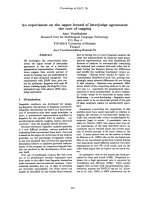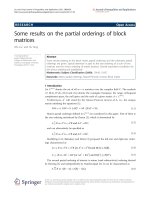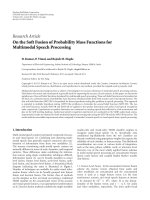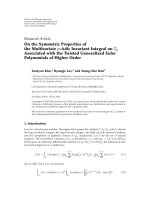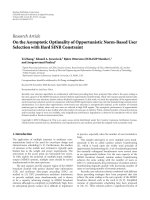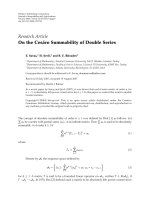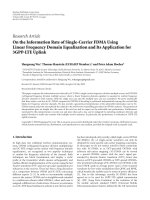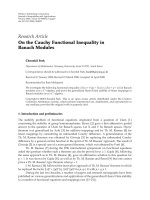Báo cáo toán học: "A Note on the Critical Group of a Line Graph" doc
Bạn đang xem bản rút gọn của tài liệu. Xem và tải ngay bản đầy đủ của tài liệu tại đây (92.35 KB, 6 trang )
A Note on the Critical Group of a Line Graph
David Perkinson
Department of Mathematics
Reed College
Nick Salter
Department of Mathematics
University of Chicago
Tianyuan Xu
Department of Mathematics
University of Oregon
Submitted: Aug 19, 2010; Accepted: May 25, 2011; Published: Jun 6, 2011
Mathematics Subject Classification: 05C20, 05C25, 05C76
Abstract
This note answers a question posed by Levine in [3]. The main result is Theo-
rem 1 which shows that under certain circumstances a critical group of a directed
graph is the quotient of a critical group of its directed line graph.
1 Introduction
Let G be a finite multidigraph with vertices V and edges E. Loops are allowed in G, and
we make no connectivity assumptions. Each edge e ∈ E has a tail e
−
and a target e
+
.
Let ZV and ZE be the free abelian groups on V and E, respectively. The Laplacian
1
of
G is the Z-linear mapping ∆
G
: ZV → ZV determined by ∆
G
(v) =
(v,u)∈E
(u − v) for
v ∈ V . Given w
∗
∈ V , define
φ = φ
G,w
∗
: ZV → ZV
v →
∆
G
(v) if v = w
∗
,
w
∗
if v = w
∗
.
The critical group for G with respect to w
∗
is the cokernel of φ:
K(G, w
∗
) := cok φ.
1
The mapping Λ: Z
V
→ Z
V
defined by Λ(f)(v) =
(v,u)∈E
(f(v) − f(u)) for v ∈ V is often called the
Laplacian of G. It is the negative Z-dual (i.e., the transp ose) of ∆
G
.
the electronic journal of combinatorics 18 (2011), #P124 1
The line graph, LG, for G is the multidigraph whose vertices are the edges of G and whose
edges are (e, f ) with e
+
= f
−
. As with G, we have the Laplacian ∆
LG
and the critical
group K( LG, e
∗
) := cok φ
LG,e
∗
for each e
∗
∈ E.
If every vertex of G has a directed path to w
∗
then K(G, w
∗
) is called the sandpile
group for G with sink w
∗
. A directed spanning tree of G rooted at w
∗
is a directed subgraph
containing all of the vertices of G, having no directed cycles, and for which w
∗
has out-
degree 0 and every other vertex has out-degree 1. Let κ(G, w
∗
) denote the number of
directed spanning trees rooted at w
∗
. It is a well-known consequence of the matrix-tree
theorem that the number of elements of the sandpile group with sink w
∗
is equal to
κ(G, w
∗
). For a basic exposition of the properties of the sandpile group, the reader is
referred to [2].
In his paper, [3], Levine shows that if e
∗
= (w
∗
, v
∗
), then κ(G, w
∗
) divides κ(LG, e
∗
)
under the hypotheses of our Theorem 1. This leads him to ask the natural question as to
whether K(G, w
∗
) is a subgroup or quotient of K(LG, e
∗
). In this note, we a nswer this
question affirmatively by demonstrating a surjection K(LG, e
∗
) → K(G, w
∗
). Further, in
the case in which the out-degree of each vertex of G is a fixed integer k, we show the
kernel of this surjection is the k-torsion subgroup of K(LG, e
∗
). These results appear
as Theorem 1 and may be seen as analogous to Theorem 1.2 of [3]. In [3], partially for
convenience, some assumptions are made about the connectivity of G which are not made
in this note. For related work on the critical group of a line graph for an undirected graph,
see [1].
2 Results
Fix e
∗
= (w
∗
, v
∗
) ∈ E. Define the modified target mapping
τ : ZE → ZV
e →
e
+
if e = e
∗
,
0 if e = e
∗
.
Also define
ρ: ZE → ZV
e →
∆
G
(w
∗
) − v
∗
− w
∗
+ e
+
if e = e
∗
,
0 if e = e
∗
.
Let k be a positive integer. The graph G is k-out-regular if the out-degree of each of
its vertices is k.
Theorem 1 If indeg(v) ≥ 1 for all v ∈ V and indeg(v
∗
) ≥ 2, then
ρ: ZE → ZV
descends to a surjective homomorphism ρ: K(LG, e
∗
) → K(G, w
∗
).
Moreover, if G is k-out-regular, the kernel of ρ is the k-torsion subgroup of K(LG, e
∗
).
the electronic journal of combinatorics 18 (2011), #P124 2
Proof. Let ρ
0
: ZV → ZV be the homomorphism defined on vertices v ∈ V by
ρ
0
(v) := ∆
G
(w
∗
) − v
∗
− w
∗
+ v
so that ρ = ρ
0
◦ τ . The mapping ρ
0
is an isomorphism, its inverse being itself:
ρ
2
0
(v) = ρ
0
(∆
G
(w
∗
) − v
∗
− w
∗
+ v)
=
e
−
=w
∗
(ρ
0
(e
+
) − ρ
0
(w
∗
)) − ρ
0
(v
∗
) − ρ
0
(w
∗
) + ρ
0
(v)
= ∆
G
(w
∗
) − ρ
0
(v
∗
) − ρ
0
(w
∗
) + ρ
0
(v)
= v.
Let ψ : ZV → ZV be the homomorphism defined on vertices v ∈ V by
ψ(v) :=
∆
G
(v) if v = w
∗
,
∆
G
(w
∗
) − v
∗
if v = w
∗
.
Let φ
G
and φ
LG
denote φ
G,w
∗
and φ
LG,e
∗
, respectively. We claim the following diagram
commutes:
ZE
τ
φ
LG
//
ZE
τ
ZV
ψ
//
ZV
ρ
0
ZV
φ
G
//
ZV.
To prove commutativity of the top square of the diagra m, first suppose e = e
∗
. Then
τ(φ
LG
(e)) = τ(∆
LG
(e)) = τ
f
−
=e
+
(f − e)
.
If e = e
∗
and e
+
= w
∗
, then
τ
f
−
=e
+
(f − e)
=
f
−
=e
+
(f
+
− e
+
) = ∆
G
(e
+
) = ψ(τ (e)).
On the ot her hand, if e = e
∗
and e
+
= w
∗
, then
τ
f
−
=e
+
(f − e)
=
f
−
=e
+
,f=e
∗
(f
+
− e
+
) + τ(e
∗
− e)
=
f
−
=e
+
,f=e
∗
(f
+
− e
+
) − w
∗
= ∆
G
(w
∗
) − v
∗
= ψ(τ (e)).
the electronic journal of combinatorics 18 (2011), #P124 3
Therefore, τ(φ
LG
(e)) = ψ(τ(e)) holds if e = e
∗
. Moreover, the equality still holds if e = e
∗
since τ(e
∗
) = 0. Hence, the top square of the diagram commutes.
To prove that the bottom square of the diagram commutes, there are two cases. First,
if v = w
∗
, then
ρ
0
(ψ(v)) =
(v,u)∈E
(ρ
0
(u) − ρ
0
(v)) =
(v,u)∈E
(u − v) = ∆
G
(v) = φ
G
(v).
Second, if v = w
∗
, then
ρ
0
(ψ(v)) = ρ
0
(∆
G
(w
∗
) − v
∗
) = ∆
G
(w
∗
) − ρ
0
(v
∗
) = w
∗
= φ
G
(v).
From the commutativity of the diagram, the cokernel of ψ is isomorphic to K(G, w
∗
),
and ρ = ρ
0
◦ τ descends to a homomorphism ρ : K(LG, e
∗
) → K(G, w
∗
) as claimed. The
hypothesis on the in-degrees of the vertices assures that τ , hence ρ, is surjective.
Now suppose that G, hence LG, is k-out-regular. This part of our proof is an adap-
tation of that given for Theorem 1 .2 in [3]. Since ρ
0
is an isomorphism, it suffices to
show that the kernel of the induced map, τ : K(LG, e
∗
) → cok ψ, has kernel equal to the
k-torsion of K(LG, e
∗
). To this end, define the homomorphism σ : ZV → ZE, given on
vertices v ∈ V by
σ(v) :=
e
−
=v
e.
We claim that the image of σ ◦ ψ lies in the image of φ
LG
, so that σ induces a map, σ,
between cok ψ and K(LG, e
∗
). To see this, first note that for v ∈ V ,
σ(∆
G
(v)) = σ
e
−
=v
e
+
− kv
=
e
−
=v
f
−
=e
+
f − k
e
−
=v
e
=
e
−
=v
∆
LG
(e)
Therefore, for v = w
∗
, it follows that σ(ψ(v) ) is in the image of φ
LG
. On the other hand,
using the calculation just made,
σ(∆
G
(w
∗
) − v
∗
) =
e
−
=w
∗
∆
LG
(e) −
f
−
=v
∗
f
=
e
−
=w
∗
∆
LG
(e) −
f
−
=v
∗
f − k e
∗
+ k e
∗
=
e
−
=w
∗
∆
LG
(e) − ∆
LG
(e
∗
) − k e
∗
=
e
−
=w
∗
,e=e
∗
∆
LG
(e) − k e
∗
,
which is also in the image of φ
LG
.
the electronic journal of combinatorics 18 (2011), #P124 4
We have established the mappings
cok ψ
σ
K(LG, e
∗
)
τ
ll
.
For e = e
∗
,
σ(τ(e)) =
f
−
=e
+
f = ∆
LG
(e) + k e = k e ∈ K(LG, e
∗
).
Thus, the kernel of τ is contained in the k-torsion of K(LG, e
∗
), and to show equality it
suffices to show that σ is injective.
The case where k = 1 is trivial since there are no G satisfying the hypotheses: if G is
1-out-regular and indeg(v) ≥ 1 for all v ∈ V , then indeg(v) = 1 for all v ∈ V , including v
∗
.
So suppose that k > 1 and that η =
v∈V
a
v
v is in the kernel of σ. We then have
σ(η) =
v∈V
e
−
=v
a
v
e =
e=e
∗
b
e
∆
LG
(e) + c e
∗
(1)
for some integers b
e
and c. Comparing coefficients in (1) gives
a
e
−
=
f
+
=e
−
,f=e
∗
b
f
− k b
e
for e = e
∗
. (2)
Define
F (v) =
1
k
f
+
=v,f=e
∗
b
f
− a
v
.
From ( 2),
F (e
−
) = b
e
for e = e
∗
. (3)
Since k > 1, for each vertex v, we can choose an edge e
v
= e
∗
with e
−
v
= v. By (2)
and (3), for all v ∈ V ,
a
v
=
f
+
=v,f=e
∗
b
f
− k b
e
v
=
f
+
=v,f=e
∗
F (f
−
) − k F (v).
Therefore, as an element of cok ψ,
η =
a
v
v =
e=e
∗
F
e
−
e
+
−
v∈V
kF (v)v
=
v∈V,v=w
∗
F (v)
e
−
=v
e
+
− kv
+ F (w
∗
)
e
−
=w
∗
,e=e
∗
e
+
− kw
∗
=
v∈V,v=w
∗
F (v)∆
G
(v) + F (w
∗
)(∆
G
(w
∗
) − v
∗
)
= 0,
which shows that σ is injective.
the electronic journal of combinatorics 18 (2011), #P124 5
Acknowledgement
We extend our thanks to our anonymous referee for a careful reading and helpful com-
ments.
References
[1] Andrew Berget, Andrew Manion, Molly Maxwell, Aaron Potechin, and Victor Reiner.
The critical group of a line graph. arxiv:math.CO/0904.1246.
[2] Alexander E. Holroyd, Lionel Levine, Karola M´esz´aros, Yuval Peres, James Propp,
and David B. Wilson. Chip-firing and rotor-routing on directed graphs. In In and
out of equilibrium. 2, volume 6 0 of Progr. Probab., pages 331–364. Birkh¨auser, Basel,
2008.
[3] Lionel Levine. Sandpile groups and spanning trees of directed line graphs. Journal of
Combinatorial Theory, Series A, 118:350–364, 2011.
the electronic journal of combinatorics 18 (2011), #P124 6

